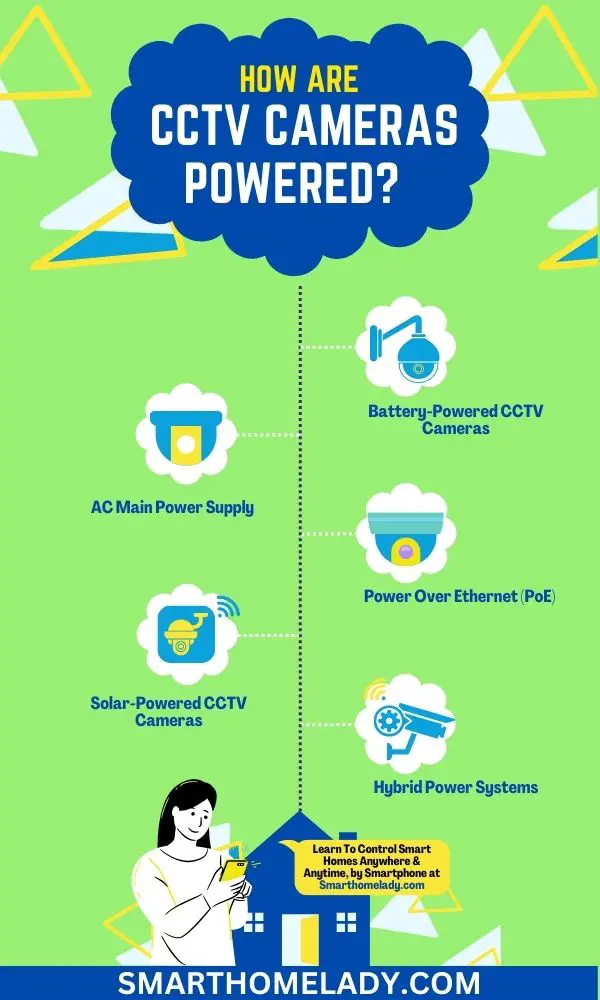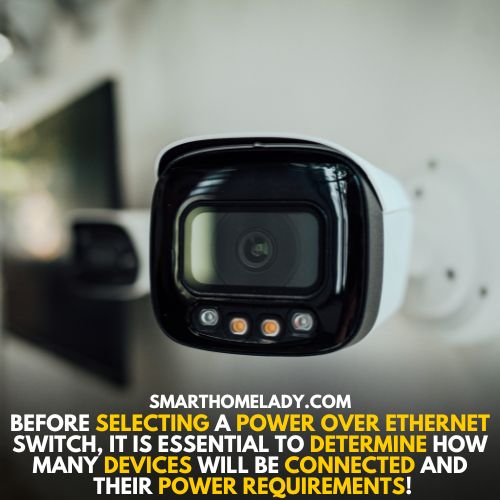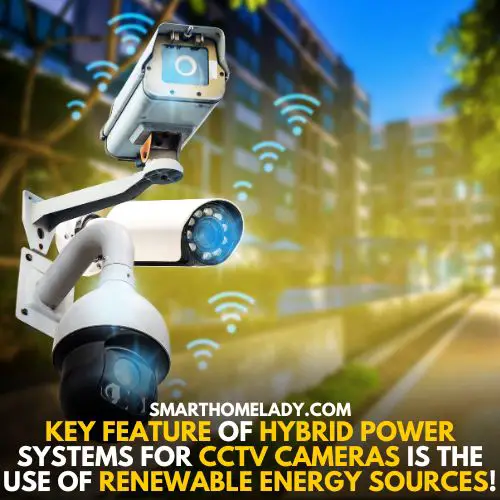CCTV cameras have become an essential tool for ensuring security and preventing crime. They are widely used in public places, businesses, and homes to monitor activities around the clock.
However, one crucial aspect of CCTV camera operation that often goes unnoticed is how they are powered.
CCTV camera power systems vary depending on the type and location of the camera installation. Understanding how these cameras are powered can help ensure their optimal performance and longevity.
This article will explore “how are CCTV cameras powered and what are the different types of CCTV camera power systems available,” including AC mains power supply, Power over Ethernet (PoE), battery-powered options, solar-powered solutions, and more.
We will also examine the factors that influence which option is best suited for specific applications.

Contents
- 1 How Are CCTV Cameras Powered – 6 Types Of CCTV Cameras
- 2 Factors To Consider When Choosing A CCTV Camera Power System
- 3 Do CCTV cameras need a power supply?
- 4 How to give power to CCTV cameras?
- 5 Do Wireless CCTV Cameras Need Power?
- 6 How much power does a CCTV camera need?
- 7 How do home security cameras get power?
- 8 How do wired security cameras get power?
- 9 Conclusion
How Are CCTV Cameras Powered – 6 Types Of CCTV Cameras
Understanding the power requirements of CCTV cameras is crucial for their proper functioning. Camera power sources can vary depending on the type of camera and its location.
A simple AC adapter plugged into a wall outlet may be sufficient for indoor cameras to power the device. However, outdoor cameras require more robust power sources due to exposure to harsh weather conditions.
These typically come as Power over Ethernet (POE) injectors or switches that supply data and power through a single cable.
Wireless cameras also have specific power requirements as they rely on batteries or solar panels for their operation. The battery life will depend on various factors, such as usage frequency, temperature, and battery capacity.
Solar-powered cameras are an excellent option if you need remote surveillance without access to a mains power supply.
Understanding the different types of CCTV camera power systems can help ensure that your security system operates smoothly with minimal downtime. Here are 6 types of cameras that rely on different power sources.
1. AC Main Power Supply
CCTV cameras are powered by various means, but the most common is AC main power supply.
This involves connecting the camera to a wall outlet using a power adapter or transformer that converts high-voltage AC current from the mains to low-voltage DC current suitable for powering the camera’s internal components.
However, this method of powering CCTV cameras can be vulnerable to power outages and voltage fluctuations, which can damage or disable the cameras.
To mitigate these risks, many surveillance systems incorporate UPS backup units that provide temporary battery power during an outage and regulate incoming electricity to prevent damaging surges or drops in voltage.
Voltage fluctuations can also cause image quality issues, such as flickering or distortion on video feeds.
Therefore, it is essential to ensure that your CCTV system has stable and consistent power input through a reliable AC mains supply and appropriate backup measures like UPS systems.

While AC mains power supply remains a popular choice for powering CCTV cameras, there is another option gaining popularity due to its convenience and efficiency – Power over Ethernet (PoE).
2. Power Over Ethernet (PoE)
PoE installation allows you to power your IP camera with a single ethernet cable that connects to both the network and the camera.
One of the advantages of using PoE is its flexibility in powering various devices, including CCTV cameras.
Before selecting a PoE switch, it is essential to determine how many devices will be connected and their power requirements.
A high-wattage device may overload a lower-powered switch leading to system failure. When choosing a PoE switch, ensure that it can handle all the devices’ power needs while leaving room for future expansion or upgrades.
Additionally, some switches offer advanced features such as remote management capabilities, which allow easy monitoring of each port’s status and traffic levels.
By selecting an appropriate switch, you can achieve reliable and efficient operation for your CCTV camera system.

3. Battery-Powered CCTV Cameras
Battery-powered CCTV cameras are a popular option for surveillance systems that require flexibility and mobility.
These cameras typically rely on rechargeable batteries to function, which can be charged using various methods such as USB cables or wireless options.
One of the most common charging methods is through USB cables connected to power sources like computers or wall outlets.
Some battery-powered CCTV cameras also come with their own charging docks, making it easier to charge multiple batteries at once. Wireless charging options are becoming more prevalent in the market, allowing users to charge their cameras without cords.
However, the use of batteries also comes with some disadvantages.
- One major disadvantage is that battery life is limited and requires frequent replacement or recharging.
- Additionally, extreme temperatures can affect battery performance, making it difficult to rely on them in harsh weather conditions.
Despite these limitations, there are still many advantages to using battery-powered CCTV cameras, such as their flexibility in installation and portability.
Overall, battery-powered CCTV cameras provide an efficient and convenient solution for security needs.
However, it’s important to note that battery life varies depending on usage frequency and camera settings. Users should take care to monitor the battery level regularly and have spare batteries ready when needed.
4. Solar-Powered CCTV Cameras
Another option for powering CCTV cameras is solar energy. Solar-powered systems utilize photovoltaic panels to convert sunlight into electricity to power the camera system.
This method offers several benefits over traditional wired systems since it does not require any external power source and eliminates the need for expensive cabling installations.
However, solar-powered systems do have some installation requirements that must be met before they can operate efficiently. For example,
- Sufficient exposure to direct sunlight is necessary for optimal performance.
- Additionally, proper placement of the panels and efficient storage mechanisms must also be considered when designing a solar-powered CCTV system.
Overall, while solar-powered CCTV cameras offer significant environmental sustainability advantages compared to other options available today, careful planning and preparation are required during installation to ensure long-term operational efficiency.
5. Hybrid Power Systems
CCTV cameras are powered by hybrid power systems that utilize both traditional and renewable energy sources.
These systems are designed to ensure the uninterrupted operation of CCTV cameras in the event of a power outage or failure.
One component of these hybrid systems is battery backup, which provides emergency power when the primary source is unavailable.
The batteries can be charged using solar panels or other renewable energy sources during normal operation, thereby reducing reliance on non-renewable energy sources.
Another key feature of hybrid power systems for CCTV cameras is the use of renewable energy sources such as wind turbines or hydroelectric generators.

These sources provide clean and sustainable energy, which reduces carbon emissions and contributes positively to environmental conservation efforts.
- Hybrid power systems reduce reliance on non-renewable energy sources.
- Battery backup ensures uninterrupted camera operation during emergencies.
- Renewable energy sources contribute positively to efforts toward environmental sustainability.
Hybrid power systems represent an innovative approach to powering CCTV cameras while mitigating negative impacts on the environment. By harnessing both traditional and renewable energy sources, these systems offer reliable service even during outages or failures.
6. External Power Sources
Hybrid power systems have become popular in recent years as they provide a reliable and cost-effective way to power CCTV cameras. However, these systems may not always be feasible or practical, especially for remote locations or temporary setups.
In such cases, portable generators can be used to power the cameras. These generators are easy to transport and set up, making them ideal for short-term projects.
They also come in various sizes and capacities, allowing users to choose one that suits their specific needs.
Factors To Consider When Choosing A CCTV Camera Power System
When choosing a CCTV camera power system, there are several factors to consider. The following are a few factors to consider;
1. Wired Vs Wireless System
One of the primary considerations is whether to use wired or wireless cameras. Wired systems offer reliable and consistent power, but they can be difficult to install in some locations.
Wireless systems, on the other hand, are easier to install but may require more frequent battery replacements.
2. Voltage Requirements
Another important consideration is voltage requirements. Different cameras have different voltage needs, so it’s essential to choose a power supply that meets those requirements.
Failure to do so could result in damage to the camera or decreased performance.

3. Backup Power Sources
It’s important to consider backup power sources such as solar panels or generators. These should be used in case of unexpected outages or emergencies when regular power sources fail.
A backup generator can provide a long-lasting source of energy, while solar panels can generate electricity from sunlight during the day.
4. Location And Environment
After considering the factors in choosing a CCTV camera power system, one must take into account the location and environment where the cameras will be installed. This is crucial in determining how the cameras will be powered and whether installation challenges may arise.
For instance, outdoor cameras require more robust power solutions than indoor ones due to exposure to harsh weather conditions such as rain or extreme heat.
Additionally, remote locations may pose difficulties in accessing grid power sources, necessitating alternative methods like solar-powered systems.
5. Power Consumption
CCTV cameras require a power source to function, and the method of powering them can vary depending on the type of camera. Power consumption is an important factor when considering CCTV cameras as it affects their efficiency and overall performance.
One common way to power CCTV cameras is through a direct connection to AC power. This method involves running wires from the camera to a nearby outlet or switchboard, which can often be expensive and time-consuming.
However, this method ensures constant power supply and voltage regulation for optimal performance.
Another option is using PoE (Power over Ethernet) technology that allows both data transfer and power delivery through Ethernet cables connected to a network switch. This method eliminates the need for separate electrical wiring while also providing better power efficiency with less energy waste.
6. Budget And Maintenance
Cost-effectiveness plays a crucial role when deciding CCTV camera power system. While a DC power supply may be cheaper upfront, its maintenance schedule includes regular checkups to ensure proper functioning and prevent breakdowns.
Whereas replacing and recharging batteries might seem like a cost-effective solution initially but will require frequent replacements, which could increase expenditure over time.
When considering the best way to power your CCTV system, remember to consider factors such as location accessibility, budget constraints, and maintenance schedules before settling on a particular option.
Do CCTV cameras need a power supply?
Yes, CCTV cameras require a power supply to function. They need a constant flow of electricity to operate and capture footage.
Without power, they won’t work, and you won’t be able to monitor your property.
How to give power to CCTV cameras?
You can give power to CCTV cameras in several ways. The most common method is to connect them to a power outlet using a power adapter.
You can also use a PoE (Power over Ethernet) switch to supply power and data to the cameras through a network cable.
Some cameras also come with rechargeable batteries that you can charge using a USB cable.
Do Wireless CCTV Cameras Need Power?
Yes, wireless CCTV cameras need power to function. Although they don’t require a wired connection to transmit data, they still need a power source to operate.
Most wireless cameras come with rechargeable batteries that you can charge using a USB cable or a solar panel. Some models also come with a power adapter that you can plug into a power outlet.
How much power does a CCTV camera need?
The amount of power a CCTV camera needs depends on its type and features. Generally, most cameras require between 12V and 24V DC and consume around 5-15 watts of power.
However, some high-end cameras with advanced features, such as PTZ (pan-tilt-zoom) and IR (infrared), require more power, approximately 10-40 watts.
How do home security cameras get power?
Home security cameras get power from a variety of sources. Some cameras plug into a power outlet using a power adapter, while others use PoE (Power over Ethernet) technology to draw power and data through a network cable.
Some cameras also come with rechargeable batteries that you can charge using a USB cable or a solar panel.
How do wired security cameras get power?
Wired security cameras get power through a power adapter that you plug into a power outlet. The adapter converts AC power into DC power and sends it to the camera through a cable.
Some cameras also use PoE (Power over Ethernet) technology to draw power and data through a network cable, eliminating the need for a separate power supply.
Conclusion
In conclusion, understanding how CCTV cameras are powered is crucial for ensuring their proper functioning and reliability. Depending on the type of camera, there are different power options, including AC mains supply, PoE, and battery-powered systems.
It’s important to consider factors such as location and environment, power consumption, and budget when choosing a power system.
Think of it like a vehicle – just as you wouldn’t use gasoline in a diesel engine or vice versa, selecting the wrong power source can have disastrous consequences for your CCTV system.
As a smart home lady, I understand the importance of precision and accuracy in conveying information about CCTV camera power systems. By taking into account all relevant factors, you can make an informed decision that will ensure your security needs are met efficiently and effectively.


